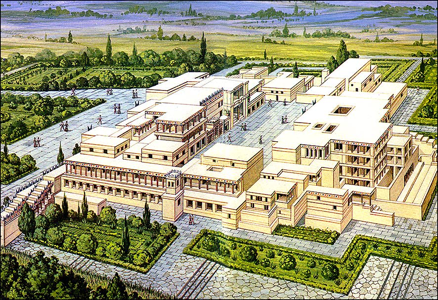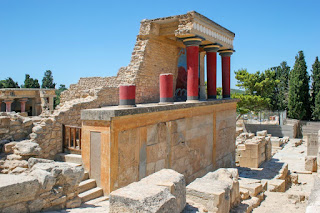
Crete is the largest island within the East Mediterranean Sea, 100 km South-East of terra firma Greece. it has remains of the Minoan civilization 3000 - 1400 B.C. and was in turn under Roman, Byzantine, Venetian, and Turkish rule. The island was annexed by Greece in 1913.
In 1941 it had been captured by German forces from Allied troops who had retreated from the mainland and was retaken by Allies in 1944.
The Palace of Knossos
Knossos is the Chief town of Minoan Crete, close to present-day Iraklion, 6 km SE of Candia. The archaeological site, excavated by Sir Arthur John Evans (1899-1935) dates from about 2000-1400
before Christ and includes the Palace throne room, the remains of frescoes, and construction on more than one level.The royal palace of Knossos in Crete was a true town city a city. The palace was engineered around a huge courtyard and contained over a thousand rooms. It conjointly had a rectangular open-air theatre, may be used for ritual performances.
The palace had a clever system of plumbing for transfer potable water and for flushing away waste materials. The light was supplied from above by ‘light wells’ and colonnaded porticoes provided ventilation.
The palace was also the home of all the workers and craftsmen who produced all the tools and equipment needed at court. The artisans of Crete were excellent ceramists and potters and their vases were exported to all parts of the Mediterranean. The high level of civilization that developed on Crete had a major influence on neighboring lands, especially on the Achaeans, the ancestors of the ancient Greeks.
Ancient Cretan Writing
So far no one has been able to decipher the writing of ancient Crete of which there are many examples. Nearly 2000 thin, clay tablets were found at the Palace of Knossos. It was the first writing in which the characters run from left to fight. Sometimes, however, when the writing reached the end of a line is continued in the next line from right to left. Cretan writing is still silent but the remains so far found are eloquent witnesses of a flourishing and highly developed civilization.
The Legend of Minotaur
The site of the city of Knossos and the imposing ruins of the royal palace with its great number of rooms, passages, and tunnels, recalls the legend of the minotaur.The mythical creature, Minotaur, was a monster. He was a half-bull and a half-man. It lived in the famous labyrinth or maze which was a building composed of an intricate series of corridors and passages. Anyone entering the labyrinth found it impossible to get out again.
Every year the Cretans sacrificed seven maidens and seven youths to the minotaur. These young victims were sent from Athens in Greece which has been conquered by King Minos of Crete.
An Athenian, Prince Theseus, decided the sacrifices must stop and he came face-to-face with the monster. Theseus killed the minotaur and succeeded in getting out of the labyrinth with the help of Princess Ariadne, daughter of King Minos who had fallen in love with him.
It is difficult to say how this legend began. It is one of the most famous stories in Greek mythology. Perhaps one of the clues lies in the fact that Knossos had an arena in which tauromachy or bull-fights took place. In these fights, the bull-fighter had to grasp the charging bull by the horns and leap over its back so that it could not gore him.




